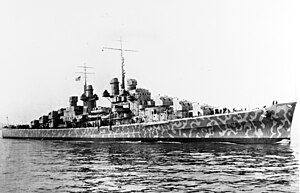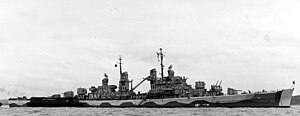USS Juneau (CL-52)

| |
| History | |
|---|---|
| Laid down | 27 May 1940 |
| Launched | 25 October 1941 |
| Commissioned | 14 February 1942 |
| Fate | Sunk, Naval Battle of Guadalcanal 13 November 1942 |
| General characteristics | |
| Displacement | 6,000 tons |
| Length | 541 ft 6 in (165.05 m) |
| Beam | 52 ft 2 in (15.90 m) |
| Draft | 16 ft 4 in (4.98 m) |
| Speed | 32 knots (59 km/h) |
| Complement | 700 officers and enlisted |
| Armament | list error: <br /> list (help) 16 × 5 in guns, 9 × 1.1 in guns 8 × 20 mm guns; 6 × depth charge projectors, 2 × depth charge tracks |
The first USS Juneau (CL-52) was a United States Navy Atlanta-class light cruiser sunk at the Naval Battle of Guadalcanal in November 1942. The five Sullivan brothers were killed as a result of its sinking.
Commissioning
She was laid down by Federal Shipbuilding Company, Kearny, New Jersey, 27 May 1940, launched 25 October 1941, sponsored by Mrs. Harry I. Lucas, wife of the mayor of the city of Juneau, Alaska, and commissioned 14 February 1942, Captain Lyman K. Swenson in command.
Following a hurried shakedown cruise along the Atlantic coast in the spring of 1942, Juneau assumed blockade patrol in early May off Martinique and Guadeloupe Islands to prevent the escape of Vichy French Naval units. She returned to New York to complete alterations and operated in the North Atlantic and Caribbean from 1 June to 12 August on patrol and escort duties. The cruiser departed for the Pacific Theater 22 August.
Pacific theater
After stopping briefly at the Tonga Islands and New Caledonia, she rendezvoused 10 September with Task Force 18 under the command of Rear Admiral Leigh Noyes, flying his flag in Wasp (CV-7). The following day Task Force 17, which included Hornet (CV-8), combined with Admiral Noyes' unit to form Task Force 61, whose mission was to ferry fighter aircraft to Guadalcanal. On 15 September Wasp took three torpedo hits from the Japanese submarine I-19, and, with fires raging out of control, was sunk at 21:00 by Lansdowne (DD-486). Juneau and screen destroyers rescued 1,910 survivors of Wasp and returned them to Espiritu Santo, New Hebrides, on 16 September. The next day the fast cruiser rejoined Task Force 17. Operating with the Hornet group, she supported three actions that repulsed enemy thrusts at Guadalcanal: the Buin-Fasi-Tonolai Raid; the Battle of the Santa Cruz Islands; and the Naval Battle of Guadalcanal (Third Savo).
Battle of the Santa Cruz Islands
The ship's first major action was the Battle of the Santa Cruz Islands on 26 October. On 24 October Hornet's task force had combined with the Enterprise (CV-6) group to reform Task Force 61 under the command of Rear Admiral Thomas C. Kinkaid. This force positioned itself north of the Santa Cruz Islands in order to intercept enemy units that might attempt to close Guadalcanal. Meanwhile, on Guadalcanal, the Japanese achieved a breakthrough along Lunga Ridge on the night of 25 October. That success evidently was a signal for enemy surface units to approach the island.
Early in the morning 26 October, U.S. carrier planes uncovered the enemy force and immediately attacked it, damaging two Japanese carriers, one battleship, and three cruisers. But while American aircraft were locating and engaging the enemy, American ships were also under fire. Shortly after 10:00 some 27 enemy aircraft attacked Hornet. Though Juneau and other screen ships threw up an effective AA barrage which splashed about 20 of the attackers, Hornet was badly damaged and sank the next day. Just before noon Juneau left Hornet's escort for the beleaguered Enterprise group several miles away. Adding her firepower, Juneau assisted in repulsing four enemy attacks on this force and splashing 18 Japanese planes.
That evening the American forces retired to the southeast. Although the battle had been costly, it, combined with the Marine victory on Guadalcanal, turned back the attempted Japanese parry in the Solomons. Furthermore, the damaging of two Japanese carriers sharply curtailed the air cover available to the enemy in the subsequent Naval Battle of Guadalcanal.
Naval Battle of Guadalcanal
On 8 November Juneau departed Nouméa, New Caledonia, as a unit of Task Force 67 under the command of Rear Admiral Richmond K. Turner to escort reinforcements to Guadalcanal. The force arrived there early morning 12 November, and Juneau took up her station in the protective screen around the transports and cargo vessels. Unloading proceeded unmolested until 14:05 when 30 Japanese planes attacked the alerted United States group. The AA fire was effective, and Juneau alone accounted for six enemy torpedo planes shot down. The few remaining attackers were then attacked by American fighters; only one bomber escaped. Later in the day an American attack group of cruisers and destroyers cleared Guadalcanal on reports that a large enemy surface force was headed for the island. At 0148 on 13 November Rear Admiral Daniel J. Callaghan's relatively small Landing Support Group engaged the enemy. The Japanese force consisted of two battleships, one light cruiser, and nine destroyers.

Due to bad weather and confused communications, the battle occurred in close to pitch darkness and at almost point-blank range as the ships of the two sides intermingled with each other. During the melee, Juneau was struck on the port side by a torpedo causing a severe list, stopping her dead in the water, and necessitating withdrawal. Before noon 13 November, Juneau, along with two other cruisers damaged in the battle — Helena, and San Francisco — left the Guadalcanal area to return to Espiritu Santo for repairs. Juneau was steaming on one screw, keeping station 800 yards on the starboard quarter of the likewise severely damaged San Francisco (CA-38). She was down 12 feet by the bow, but able to maintain 13 knots. A few minutes after 11:00 three torpedoes were launched from the B1 type submarine I-26. Juneau successfully avoided two, but the third struck her at the same point which had been damaged during the surface action. There was a great explosion; Juneau broke in two and disappeared in 20 seconds. Fearing more attacks from the I-26, the Helena and San Francisco continued-on without attempting to rescue survivors. Although the ship went down with heavy loss of life, more than 100 survivors had survived the sinking. They were left to fend on their own in the open ocean for eight days before rescue aircraft belatedly arrived. While awaiting rescue, all but 10 died from the elements and savage shark attacks, including Captain Swenson and the two remaining Sullivan brothers. (The other three died as a direct result of the 2nd torpedo.) (Kurzman, 1994).
Juneau received four battle stars for World War II service.
See also
- See List of U.S. Navy losses in World War II for other Navy ships lost in WWII.
- USS The Sullivans (DD-537)
References
 This article incorporates text from the public domain Dictionary of American Naval Fighting Ships. The entry can be found here.
This article incorporates text from the public domain Dictionary of American Naval Fighting Ships. The entry can be found here.- Kurzman, Dan (1994). Left to Die: The Tragedy of the USS Juneau. New York: Pocket Books. ISBN 0-671-74874-2.
